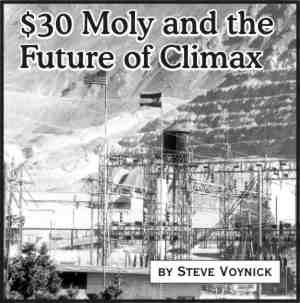Article by Steve Voynick
Mining – July 2005 – Colorado Central Magazine
EVERY TEN YEARS OR SO, the Climax Mine seems poised to rise from its ashes, hiring hundreds of miners, bringing the good times back to Leadville, and reclaiming some measure of its former glory as a major source of molybdenum. After circulating quietly for a year, new rumors went public on May 26 with a front-page article in Leadville’s Herald Democrat headlined: Is Climax Making a Comeback?
Such rumors have made the rounds before, but this time they may have a bit more substance. The Phoenix, Arizona-based Phelps Dodge Corporation, which owns the Climax Mine, recently commissioned two contractors to conduct six-month-long studies to determine the economic feasibility of reopening the mine.

The reason for the interest in reopening Climax, of course, is the soaring price of molybdenum. Three short years ago, the price of “moly” wallowed at $2.50 per pound. But by January 2004 it had climbed to a respectable $5. Then, in just the past 18 months, it rocketed to $37. With production costs for most molybdenum mines at around $3 to $6 per pound, $37 moly means hefty profits–hefty enough to question why Phelps Dodge hasn’t already re-opened Climax.
For one thing, the last time the price of moly neared $30 per pound was 1981, a year that Central Colorado remembers all too well. Back then, $30 moly proved disastrous for both Climax and its parent company AMAX. When the smoke cleared after the record prices had radically restructured the molybdenum market, the big winners then were the copper companies that recovered by-product moly, along with producers of such alternative alloying metals as vanadium. The big losers were Climax and AMAX, which, as prices collapsed under sagging demand and booming supply, found themselves priced out of a new global market.
Although today’s molybdenum market is quite different from that of a quarter-century ago, certain factors have a haunting similarity, good reason for Phelps Dodge to be cautious about reopening Climax.
In 1980, primary molybdenum mines like Climax that produced moly as its foremost economic product, accounted for 75 percent of world supply. Today, copper mines that turn out by-product moly account for 75 percent of world supply. Because moly makes up only a fraction of one percent of some copper ores, it’s the copper price, not the moly price, that drives production. High copper prices and increased copper production translate directly to higher recovery of by-product molybdenum. Most primary mines are now relegated to the roles of “swing producers,” mines that adjust, or in the case of Climax, suspend, production in accordance with market prices.
WORLD MOLYBDENUM OUTPUT is now about 300 million pounds per year. The United States remains the top producer, with seven active mines providing one-third of the world’s moly. Among them are four copper mines in Montana, Utah, and Arizona. Also included are three primary moly mines which are all swing producers: the Henderson Mine (Phelps Dodge) near Idaho Springs, Colorado; the Questa Mine (Molycorp) near Questa, New Mexico; and the Thompson Creek Mine (Thompson Creek Metals) in Idaho. Climax, another swing producer, is currently inactive.
Chile and China closely trail the United States in moly production, each accounting for roughly 30 percent of world output. The emergence of China as a major producer has had an unusual impact on the moly market.
While most available molybdenum is alloyed with steels and stainless steels, 20 percent is used as chemical catalysts, and the small remainder goes to applications ranging from pigments to lubricants. Over the past 24 years, global demand for moly has doubled. But supply, partly because of rising Chinese exports, has kept pace, holding prices as low as $2.50 per pound.
When a modest price spike occurred in 1986, AMAX reopened Climax for a brief and unprofitable period of production. Another spike came in 1994, when lingering effects from the earlier collapse of the Soviet Union drove the price to $6. This time, Cyprus-AMAX, the new Climax owner, rushed to reopen the mine the following year. It succeeded–just as the price collapsed.
The moly market began shaking itself out of its doldrums again in 2002 when, for the first time in 24 years, global demand overtook supply. When the European Union imposed a stiff tariff on Chinese moly, the supply tightened further and pushed the annual average price to an encouraging $3.75.
Then in 2003, steadily escalating oil and gas prices triggered a big rise in exploration and production drilling, boosting demand for high-molybdenum oil-field steel and raising the average price to $5.29.
FINALLY, IN 2004, China, riding a phenomenal wave of economic expansion, ceased exporting moly and became a net importer. That sharply curtailed supply, driving the price to $13.40 per pound. All U.S. swing producers, which had been operating at less than half their capacity, began stepping up production. Phelps Dodge wasted no time at Henderson, plowing in $20 million to increase its 2005 production rate to 32 million pounds and reach capacity production of 40 million pounds by 2006.
Now, with the moly price above $30, Phelps Dodge faces a decision about the Climax Mine. Should the moly price remain high, and Climax remain idle, Phelps Dodge stockholders would rightfully scream. But because Climax would be unlikely to achieve any significant production before 2007, the current high moly price alone is not a valid basis for a decision. The real issue becomes one of predicting the future market, a dangerous game with potential for huge financial gains–or devastating losses.
Many factors figure into moly-market predictions. A drop in energy prices could slow drilling activity and reduce demand for oil-field steel. An economic downturn could put the brakes on the steel industry, while an increase in copper prices could boost moly output. And China remains a huge question mark. Having dumped moly on the market before, it could certainly do so again, cleaning up financially before deflating the market price. On the other hand, the opposite scenarios together could drive moly prices even higher.
Keep in mind also that by 2007, much more moly will be reaching the market. Henderson, Questa and Thompson Creek will all be producing at capacity or near-capacity rates. Several mills at copper mines in Arizona and Chile will have constructed new by-product moly-recovery circuits. Meanwhile, Idaho General Mines is planning to develop over the next 20 months a new, $400-million, primary molybdenum mine in Nevada, while Kobex Resources is rushing to complete a feasibility study aimed at development of Idaho’s Cumo molybdenum deposit. And China promises to increase its moly production, but what it will do with it is unclear.
IN ONE OF THE BIGGEST ironies of all, a re-opened Climax would contribute as much as 20 million pounds of moly to the market annually, thus in effect helping to lower the price that it would depend on for its continued operation.
Finally, there is always concern about the economic validity of price spikes, those sudden, short-term jumps that stand apart from long-term price rises. Historically, moly-market price spikes have shown little stability. Unlike long-term price trends, they are not based so much on true supply and demand as they are on fears of a moly shortage that spur speculative buying.
The consensus of metal-market analysts is that moly prices will not remain above $30. Some, in fact, believe that the price has already peaked, or will do so soon. Many expect prices to settle into the $10-to-$20 range for the next several years–a level still high enough to assure a solid profit for primary molybdenum mines.
But all these considerations address only future market conditions. Another big concern is the up-front cost of reopening the Climax Mine. Mothballed for the past ten years, the mill will certainly require major–and expensive–renovation. Remember that some $20 million was poured into Henderson just to double production at a mine that was already operating. And since Climax would be starting up from cold shutdown, hundreds of new people would have to be hired and trained just to prepare the mine and mill for production. Several years of subsequent, profitable production would be necessary to simply recoup the start-up costs.
Of course, there could be alternative approaches to production at Climax, one of which might involve Henderson. Even while the Henderson mine is running at capacity, its mill will operate below capacity. Given a high enough moly price, Climax ore could theoretically be trucked to the Henderson mill, thus eliminating, or at least postponing, the need to renovate the Climax mill.
The last thing Phelps Dodge would like to see is a reopened Climax that operates only briefly in the face of adverse market conditions. But the full costs of such a miscalculation would go far beyond the corporate bottom line. They would include the human cost to those who relocated for jobs that didn’t last. And there would also be a high community cost if Leadville had to endure yet another round of shutdowns and layoffs.
All in all, whether or not to reopen Climax is a big-league decision. Phelps Dodge is right in studying everything as thoroughly as it can. And in about six months, when all the data has been collected, interpreted, assimilated, and digested, a well-paid person high up the corporate ladder will make that decision. A lot of people, for a lot of reasons, are hoping that it’s the right one.
Steve Voynick once mined and mucked molybdenite on Frémont Pass, and is author of Climax, the history of the mine, as well as many other books about minerals and mining history.


